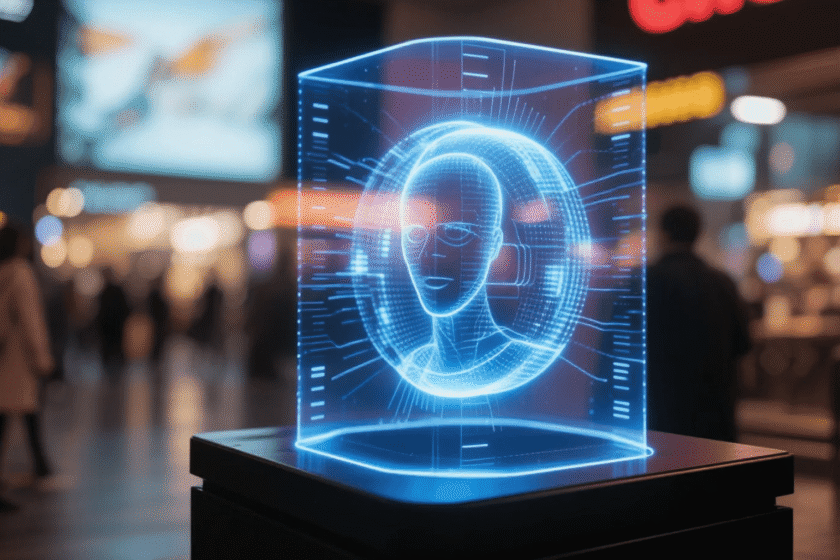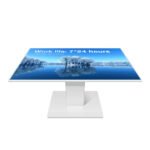Is the 3D Hologram Display the Future of Digital Signage?
Introduction: Stepping Beyond the Flat Screen Era
In the increasingly competitive landscape of retail, advertising, and public information, capturing audience attention has become paramount. For decades, digital signage has relied predominantly on flat, two-dimensional screens. While effective, these displays often blend into the background, failing to deliver the “wow” factor necessary for truly memorable consumer engagement. A transformative shift is now underway, driven by the emergence of the 3D hologram display technology. This groundbreaking innovation is poised to redefine how brands communicate, offering an unprecedented visual experience that literally pops out at the viewer. Far from being a mere gimmick, the 3D hologram display represents a significant leap in display technology, delivering depth, realism, and immersion that traditional screens simply cannot match. This article delves into the core of this technology, exploring its mechanics, distinct features, and, most importantly, its profound implications for the digital signage sector and the users who implement these solutions. Understanding this technology is crucial for any business seeking a genuine competitive edge in their visual merchandising and communication strategies.
Understanding the Mechanism: How the 3D Hologram Display Achieves the Impossible

The term “hologram” often evokes images from science fiction movies—fully realized, free-floating projections. While the current commercial technology, the 3D hologram display, operates slightly differently, the end result for the viewer is equally captivating: a three-dimensional image or animation that appears to suspend and float in mid-air.
At its most common and commercially viable form, this display technology is typically based on high-speed rotational LED fans, sometimes referred to as ‘holographic fans’ or ‘holographic projectors.’ The principle is relatively straightforward yet ingenious. A series of tightly packed LED lights are fixed onto a rotating blade or arm. When the blade spins at an extremely high velocity (often hundreds of rotations per minute), the persistence of human vision (POV) is leveraged. The viewer’s brain perceives the rapidly flashing lights from the LEDs as a continuous, solid image.
Crucially, the programming of the LEDs is synchronized precisely with the blade’s rotational position. As the blade sweeps through the air, specific LEDs turn on and off at predetermined moments, effectively drawing the image pixel by pixel in three-dimensional space. Because the physical structure supporting the LEDs (the blades) moves too quickly for the human eye to resolve, the blades become virtually invisible. Therefore, the result is a vibrant, full-color, and realistic 3D image or video seemingly floating without a screen, glasses, or physical enclosure. This effect fundamentally differentiates the 3D hologram display from conventional 3D displays that require specialized eyewear or rely on lenticular screens. The technology is sophisticated, yet the user interaction remains seamless and intuitive, which is key to its success in customer-facing applications.
The Key Differentiators: Why Choose a 3D Hologram Display Over Traditional Signage?

The decision to invest in a new display technology necessitates a clear justification of its value proposition compared to existing solutions. The distinct features of the 3D hologram display provide compelling reasons for its adoption in high-impact digital signage locations.
Unparalleled Visual Impact and Attention-Grabbing Power
The single most significant feature is the inherent ability of the 3D hologram display to attract and hold attention. Conventional screens, even large video walls, are fundamentally rectangular light boxes that are now ubiquitous. By contrast, a three-dimensional object floating in space is novel and breaks the pattern of expected visual input. Studies consistently show that the brain processes three-dimensional and moving objects with greater urgency. Consequently, this display format achieves vastly higher dwell times and recall rates for displayed content compared to flat signage. For a brand, this immediate attention capture translates directly into increased foot traffic and brand visibility.
True Depth and Spatial Realism
Unlike stereoscopic 3D, which often causes eye strain or requires a specific viewing distance, the volumetric effect produced by the 3D hologram display is perceived naturally. Content can be designed to appear as if it is physically extending from the device, giving products or abstract concepts a tangible presence. Imagine a holographic sneaker rotating in mid-air above a store shelf, or a watch’s intricate mechanics visibly floating. This realism enhances the perceived value and quality of the advertised product. Moreover, this spatial quality allows for unique creative narratives that are impossible on a flat screen, offering new avenues for storytelling and product demonstration.
Flexibility in Installation and Content Creation
Modern 3D hologram display units are designed with modularity in mind. Multiple units can be synchronized and tiled together to create significantly larger holographic walls or sequences, offering scalability for various environments, from small retail displays to massive exhibition booths. Furthermore, the technology is often cloud-managed, allowing for rapid content changes and scheduling across a network of devices—a critical feature for enterprise-level digital signage users. While the content must be specially rendered (typically as a black background video for maximum effect), the development pipeline is becoming increasingly streamlined, integrating with standard 3D modeling and animation software.
Targeted Application: Revolutionizing Digital Signage and Customer Engagement

The true potential of the 3D hologram display is best realized within the dynamic, customer-facing environment of digital signage. Users responsible for deploying these solutions, from retail brand managers to airport and mall operators, should focus on scenarios where maximum impact and interactivity are necessary.
High-Impact Retail and Product Launches
In retail settings, the technology moves beyond simple advertising; it becomes a sales tool and a centerpiece. Placing a 3D hologram display at the point of purchase or in a storefront window dramatically increases the likelihood of a shopper pausing. For instance, luxury brands utilize this technology to showcase intricate details of jewelry, accessories, or electronic components, creating a high-perceived value through technological sophistication. During a new product launch, a holographic projection creates buzz and excitement that a standard poster or even a high-definition TV screen cannot replicate. It transforms a passive viewing experience into an active, almost magical encounter.
Trade Shows, Exhibitions, and Corporate Lobbies
The primary challenge at trade shows is standing out among hundreds of competitors. A large-scale 3D hologram display acts as an immediate beacon, drawing crowds to a booth. Companies use it to project complex data models, architectural blueprints, or large machinery in a compact, captivating format. Similarly, in corporate headquarters or museum lobbies, holographic displays can present company histories, complex data visualizations, or interactive maps in a cutting-edge format that reinforces a brand’s image as forward-thinking and innovative.
Enhancing Wayfinding and Public Information
While traditionally associated with commercial advertising, the 3D hologram display holds promise for public services. Imagine a holographic arrow or figure appearing to float above an intersection in a mall or airport, providing dynamic and highly visible wayfinding instructions that are harder to ignore than a static sign. The novelty ensures compliance and reduces confusion. This application emphasizes clarity and utility, proving the technology’s value extends beyond mere entertainment.
Practical Considerations for Implementation and ROI
For the digital signage user, adopting the 3D hologram display involves several practical considerations that affect deployment and the ultimate return on investment (ROI).
Content Optimization and Design
Success with this medium hinges entirely on content. The 3D effect is maximized when content is designed specifically for the holographic medium. Simple 2D videos projected onto the device will not yield the desired result. Content creators must understand the display’s radial limitations and, crucially, use pure black backgrounds to ensure that the blades effectively “disappear.” Investment in quality 3D rendering and animation talent is essential to fully exploit the technology’s potential. A well-designed holographic asset ensures maximum brand recall and visual impact.
Installation Environment and Safety
The nature of the fan-based display requires careful environmental consideration. While modern units are often encased or protected, the devices should be mounted securely and placed out of immediate reach in public areas to ensure safety and prevent tampering. The lighting conditions in the installation area are also important. While the LED brightness is substantial, excessive direct sunlight can diminish the contrast and the perceived “floating” effect. Therefore, optimal placement is often indoors or in shaded areas. System integrators should plan power and data connectivity meticulously, often favoring ceiling or wall mounts for best visibility.
Cost-Effectiveness and Longevity
Although the initial investment for a high-quality 3D hologram display unit is higher than for an equivalent-sized flat screen, the total cost of ownership is competitive when factoring in engagement rates. The display’s ability to generate significantly higher levels of engagement and conversions often results in a faster and superior ROI. Furthermore, LED technology boasts a long operational lifespan and high energy efficiency, ensuring years of low-maintenance, high-impact performance. The unique value provided by the visual experience justifies the premium cost, especially for flagship retail locations or mission-critical advertising campaigns.
Looking Ahead: The Evolution and Ethical Dimension of Holographic Signage
The current generation of the 3D hologram display is just the beginning. Research continues into truly lens-free, volumetric displays that project without mechanical movement. As manufacturing scales, costs will inevitably decrease, making this technology accessible to a wider range of businesses, from local cafes to global chains. Furthermore, the integration with AI and sensing technologies is on the horizon, allowing for dynamic content that reacts in real-time to audience movement, demographics, or even emotional responses.
Ethically, users of this technology must ensure content remains respectful and non-intrusive. The technology is powerful and attention-demanding, and its use should align with responsible advertising practices. The focus must always be on providing utility and value to the viewer, rather than simply bombarding them with inescapable visuals. A well-executed holographic display is a delightful surprise, not a visual assault. By maintaining this perspective, the 3D hologram display will secure its place as a positive and powerful tool in the evolving digital signage ecosystem.
The evidence is clear: the 3D hologram display offers a transformative pathway for digital signage users to break through the visual clutter of the modern commercial environment. It delivers depth, dynamism, and engagement that fundamentally changes the interaction between a brand and its audience. As the technology matures and content creation becomes more accessible, it is not just a trend but a foundational shift toward the future of immersive visual communication.
FAQ (Frequently Asked Questions)
Q1: Do I need special glasses to view the content on a 3D hologram display? A: No. One of the primary advantages of this technology is that the 3D effect is volumetric and utilizes the persistence of human vision, meaning no special glasses or eyewear are required for viewers to perceive the floating, three-dimensional image.
Q2: What type of content works best for a 3D hologram display? A: Content designed specifically in 3D (e.g., rotating product models, animated logos) that uses a pure black background is ideal. The black background ensures the physical blades become invisible, maximizing the illusion that the image is suspended in the air. Standard 2D video content will not achieve the desired holographic effect.
Q3: Is the 3D hologram display noisy or dangerous to install in public areas? A: Modern 3D hologram display units are engineered to operate quietly. Regarding safety, while the blades spin at high speed, units are almost always sold with protective casings or are designed for high mounting. Proper installation according to manufacturer guidelines is essential to ensure they are safely out of reach in public environments.
Q4: How does this technology compare to lenticular displays? A: Lenticular displays use specialized lenses and layered 2D images to create a 3D effect, which often requires specific viewing angles and can still appear flat or cause crosstalk. The 3D hologram display uses high-speed rotation and LEDs to project a true volumetric image that appears to float freely, offering superior depth and a more effective “out-of-the-screen” experience from a wider range of viewing positions.



